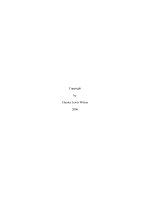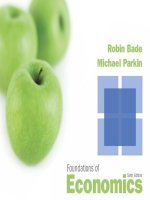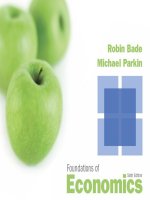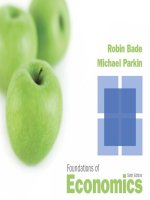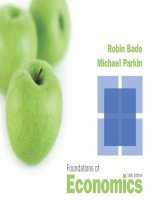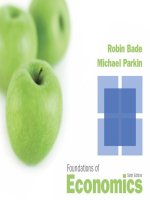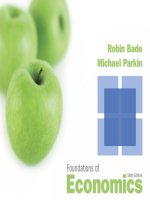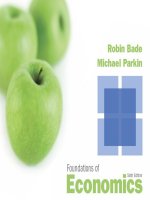Testbank of fundamental of management 7e by robin ch 05
Bạn đang xem bản rút gọn của tài liệu. Xem và tải ngay bản đầy đủ của tài liệu tại đây (163.47 KB, 48 trang )
Fundamentals of Management, 7e (Robbins/DeCenzo/Coulter)
Chapter 5 Organizational Structure and Culture
1) Organizational design is the process in which managers change or develop an organization's
structure.
Answer: TRUE
Explanation: By definition, organization design requires a manager to develop an organization's
structure, or change the structure in some way.
Diff: 2
Page Ref: 124
Objective: 5.1
2) There are four basic elements in organizational structure.
Answer: FALSE
Explanation: There are six elements: work specialization, departmentalization, authority and
responsibility, span of control, centralization and decentralization, and formalization.
Diff: 1
Page Ref: 124
Objective: 5.1
3) The original ideas about organizational design formulated by Fayol and Weber are now largely
obsolete.
Answer: FALSE
Explanation: Surprisingly, many of the ideas of Fayol and Weber about organizational design are
still valid today.
Diff: 2
Page Ref: 124
Objective: 5.1
4) When work specialization originally began to be implemented early in the twentieth century,
employee productivity initially rose.
Answer: TRUE
Explanation: Initially, managers saw huge increases in productivity as a result of specialization.
However, when work became overly specialized employee morale and motivation dropped,
erasing many productivity gains.
Diff: 2
Page Ref: 125
Objective: 5.1
5) Today, most managers see work specialization as a source of ever-increasing productivity.
Answer: FALSE
Explanation: Today managers see a limit to the amount of productivity increase they can see
from specialization. Specialization that is not deadening to employees tends to work best.
Monotonous assembly-line work seems to have diminishing returns.
Diff: 2
Page Ref: 125
Objective: 5.1
1
Copyright © 2011 Pearson Education, Inc
6) The advantage of work specialization is that it tends to result in high employee motivation and
high productivity.
Answer: FALSE
Explanation: The opposite occurs—too much work specialization results in lower motivation
and productivity.
Diff: 2
Page Ref: 125
Objective: 5.1
7) Departmentalization is a how jobs are grouped.
Answer: TRUE
Explanation: The grouping of jobs along lines of function, product, and other criteria defines
departmentalization.
Diff: 1
Page Ref: 126
Objective: 5.1
8) Staff authority is the ability to direct the work of any employee who does not have a higher
rank in the organization.
Answer: FALSE
Explanation: Staff authority is authority over support staff only, not general employees. Thus a
payroll manager has authority over payroll staff but not other organization employees.
Diff: 2
Page Ref: 126
AACSB: Analytic Skills
Objective: 5.1
9) Grouping jobs on the basis of major product areas is termed customer departmentalization.
Answer: FALSE
Explanation: Grouping along the lines of product areas is termed product departmentalization,
not customer departmentalization.
Diff: 2
Page Ref: 126
Objective: 5.1
10) Line authority can be exerted only after a manager checks with his or her superior.
Answer: FALSE
Explanation: Line authority does not require checking with superiors. It can be exerted as the
manager sees fit without any kind of consultation.
Diff: 2
Page Ref: 128
Objective: 5.1
11) Unity of command prevents an employee from trying to follow two conflicting commands at
once.
Answer: TRUE
Explanation: The original management theorists stated that subordinates should not be put in the
position to try to follow two or more conflicting commands at once. Unity of command ensured
that the command from the highest organizational level be followed.
Diff: 2
Page Ref: 129
Objective: 5.1
2
Copyright © 2011 Pearson Education, Inc
12) Power is a right that a manager has when he or she has a higher rank in an organization.
Answer: FALSE
Explanation: Power can arise from rank, but it also can arise from a particular skill, knowledge,
or access within the organization. The boss's secretary has power to gain access to the boss
without having a high rank in the organization.
Diff: 2
Page Ref: 130
Objective: 5.1
13) When decisions tend to be made at lower levels in an organization, the organization is said to
be centralized.
Answer: FALSE
Explanation: Centralized decisions originate at higher rather than lower levels of an
organization.
Diff: 2
Page Ref: 132
Objective: 5.1
14) Traditional organizations are structured in a pyramid, with the power and authority located in
the pyramid's broad base.
Answer: FALSE
Explanation: The power and authority in a traditional organization resides at the narrow point of
the pyramid where top management is located, not the base.
Diff: 2
Page Ref: 133
Objective: 5.1
15) The two prevalent organization structure models in today's world are the organic
organization and the inorganic organization.
Answer: FALSE
Explanation: The two structures are termed organic and mechanistic.
Diff: 1
Page Ref: 134
Objective: 5.2
16) A mechanistic organization is bureaucratic and hierarchical.
Answer: TRUE
Explanation: Mechanistic organizations are formal, hierarchical, impersonal, specialized, and
heavily dependent on rules and protocols.
Diff: 2
Page Ref: 134
Objective: 5.2
17) An organic organization tends to be flexible and have few formal rules.
Answer: TRUE
Explanation: An organic organization tries to be nimble in a dynamic business climate, paring
down bureaucratic complexity and focusing on innovation, flexibility, and creativity.
Diff: 2
Page Ref: 134
Objective: 5.2
3
Copyright © 2011 Pearson Education, Inc
18) Innovators need the efficiency, stability, and tight controls of a mechanistic structure rather
than an organic structure.
Answer: FALSE
Explanation: Innovators usually do better in a flexible organic structure where they are given
leeway to think creatively.
Diff: 2
Page Ref: 135
AACSB: Analytic Skills
Objective: 5.2
19) The relationship between organizational size and structure tends to be linear.
Answer: FALSE
Explanation: The greater the size of the organization, the more mechanistic it tends to be.
However, the relationship is not at all linear, but rather seems to jump at certain levels in
numbers of employees. An organization with fewer than 100 employees, for example, may be
very organic, while adding just a few more employees could cause the organization to suddenly
take on more mechanistic characteristics.
Diff: 3
Page Ref: 135-136
AACSB: Analytic Skills
Objective: 5.2
20) Joan Woodward attempted to view organizational structure from a technological perspective.
Answer: TRUE
Explanation: Woodward looked at how production methods affected organization structure.
Diff: 2
Page Ref: 136
AACSB: Technology
Objective: 5.2
21) Woodward concluded that mass production worked best with an organic organization
structure.
Answer: FALSE
Explanation: Woodward found that a mechanistic structure, rather than an organic structure,
worked best with mass production technology.
Diff: 2
Page Ref: 136
AACSB: Technology
Objective: 5.2
22) The stability of a mechanistic structure seems to work best in today's dynamic and uncertain
business environment.
Answer: FALSE
Explanation: Most managers feel that today's dynamic environment calls for a more organic
approach, not a more mechanistic approach.
Diff: 2
Page Ref: 136
AACSB: Technology
Objective: 5.2
4
Copyright © 2011 Pearson Education, Inc
23) The strength of a simple system is that everything depends on a single person.
Answer: FALSE
Explanation: Having a single person be the repository of all organizational knowledge and
power is a liability rather than a strength in many cases, if the person suddenly becomes
unavailable or unwilling to perform his or her duties.
Diff: 2
Page Ref: 137
Objective: 5.3
24) A strength of a functional structure is that it avoids duplication.
Answer: TRUE
Explanation: Putting specialties together makes departments efficient. For example, expensive
equipment can get used in one central place, eliminating the need for the same equipment to be
located elsewhere in the organization.
Diff: 2
Page Ref: 138
Objective: 5.3
25) A weakness of the divisional structure is that duplication tends to occur.
Answer: TRUE
Explanation: A divisional structure can duplicate entire departments whose tasks could
otherwise be carried out by a single, centrally located department.
Diff: 2
Page Ref: 138
Objective: 5.3
26) In a team structure, team members are not held responsible for their decisions.
Answer: FALSE
Explanation: The opposite occurs—team members make decisions and are accountable for their
decisions.
Diff: 2
Page Ref: 139
Objective: 5.3
27) In a team structure there is a clear line of managerial authority from top to bottom.
Answer: FALSE
Explanation: A team makes decisions on its own. For the most part, a team is not subject to
decisions or orders that come from outside of the team.
Diff: 2
Page Ref: 139
Objective: 5.3
28) When an employee in a matrix structure finishes a project, she goes back to her functional
department.
Answer: TRUE
Explanation: A matrix structure maintains departments. When projects are finished, employees
return to their original department.
Diff: 2
Page Ref: 139
Objective: 5.3
5
Copyright © 2011 Pearson Education, Inc
29) Employees in an organization with a matrix design can have two bosses for the same job.
Answer: TRUE
Explanation: An employee in a project group can have a project manager in addition to a
manager from his or her functional department.
Diff: 2
Page Ref: 140
Objective: 5.3
30) A significant advantage of the matrix structure is the clear chain of command from top to
bottom of the organization.
Answer: FALSE
Explanation: In a matrix structure in which employees can have multiple supervisors, the chain
of command can become confused and conflicts can arise.
Diff: 2
Page Ref: 140
Objective: 5.3
31) When an employee in a project structure finishes a project, he goes back to his original
department.
Answer: FALSE
Explanation: In a project structure an employee has no original department. Instead, after the
project ends the employee enrolls in a new project.
Diff: 2
Page Ref: 140
Objective: 5.3
32) Vertical boundaries separate employees by their rank in an organization.
Answer: TRUE
Explanation: Vertical boundaries refer to the classic corporate pyramid in which rank is
measured by how high vertically you are on the pyramid.
Diff: 2
Page Ref: 141
Objective: 5.3
33) Horizontal boundaries separate employees by the amount of power they have in an
organization.
Answer: FALSE
Explanation: Horizontal boundaries separate employees by what they specialize in, not how
much power they have.
Diff: 2
Page Ref: 141
AACSB: Analytic Skills
Objective: 5.3
34) A virtual organization relies on freelancers who have no permanent status or position in the
organization.
Answer: TRUE
Explanation: Virtual organizations keep a skeleton staff and rely on the talents of free agents
who perform the work that the organization does.
Diff: 2
Page Ref: 141
AACSB: Analytic Skills
Objective: 5.3
6
Copyright © 2011 Pearson Education, Inc
35) Managers want to eliminate boundaries in organizations primarily to increase stability and
reduce flexibility.
Answer: FALSE
Explanation: Managers want primarily to increase flexibility in boundaryless organizations
without jeopardizing stability.
Diff: 2
Page Ref: 141
Objective: 5.3
36) Horizontal boundaries separate employees by the specialization of their job.
Answer: TRUE
Explanation: Horizontal boundaries mark the difference between, for example, an ad executive
and a member of a creative advertising team. Both may have equal ranks in the organization, but
they are separated by what they do.
Diff: 2
Page Ref: 141
AACSB: Analytic Skills
Objective: 5.3
37) A virtual organization may disintegrate after it finishes its task.
Answer: TRUE
Explanation: Virtual organizations can be ad hoc. All but a few administrators can go on to work
for different companies.
Diff: 2
Page Ref: 141
Objective: 5.3
38) All learning organizations share a distinct structure.
Answer: FALSE
Explanation: Learning organizations take on a variety of different structures. Each structure is
customized for the organization and the work that it does.
Diff: 2
Page Ref: 143
Objective: 5.3
39) A company's organizational culture refers to a system of shared political beliefs.
Answer: FALSE
Explanation: A company's culture may share values and beliefs that involve the company itself,
but political beliefs are not shared.
Diff: 2
Page Ref: 145
Objective: 5.4
40) Employees learn organizational culture by reading official organization documents and
histories.
Answer: FALSE
Explanation: Employees learn corporate culture from traditions, stories, symbols, attitudes, and
many other sources. Official documents are usually not good sources for learning about
corporate culture.
Diff: 2
Page Ref: 146
Objective: 5.4
7
Copyright © 2011 Pearson Education, Inc
41) An organization's founder has little influence on its culture.
Answer: FALSE
Explanation: The founders' values and attitudes typically establish all key elements of an
organization's culture.
Diff: 2
Page Ref: 146
Objective: 5.4
42) Strong organizational culture can eliminate the need for rules and bylaws.
Answer: TRUE
Explanation: A strong culture can serve as guidelines for employees, eliminating the need for
official rules and regulations.
Diff: 3
Page Ref: 147
AACSB: Ethical Understanding and Reasoning Abilities
Objective: 5.4
43) Organizational design requires a manager to ________.
A) organize groups within an organization
B) change the culture of an organization
C) change or develop the structure of an organization
D) change the logo of an organization
Answer: C
Explanation: C) By definition, organizational design requires that an individual develop or
change an organization's structure. Changing organizational culture or organizing groups may
influence structure in minor ways, so those choices are incorrect. Changing the logo of the
organization also does not constitute creating or significantly modifying the organization's
structure.
Diff: 1
Page Ref: 124
Objective: 5.1
44) All of the following are part of the process of organizational design EXCEPT ________.
A) decide how specialized jobs should be
B) determine rules for employee behavior
C) determine the level at which decisions are made
D) determine goals for the organization
Answer: D
Explanation: D) Organizing jobs, formulating rules, or clarifying a decision-making process are
all clearly examples of developing an organization's structure. Determining goals is part of
establishing an organization's mission, not creating its structure that will help carry out that
mission.
Diff: 2
Page Ref: 124
Objective: 5.1
8
Copyright © 2011 Pearson Education, Inc
45) Which of the following are NOT basic elements of organizational structure?
A) work specialization, span of control
B) chain of command, line authority
C) centralization, decentralization
D) departmentalization, formalization
Answer: B
Explanation: B) The six elements of organizational structure are given in all three incorrect
choices. Chain of command and line authority are not included as basic elements of
organizational structure, so "chain of command, line authority" is the correct response.
Diff: 2
Page Ref: 124
Objective: 5.1
46) Which of the following is synonymous with work specialization?
A) division of labor
B) job discrimination
C) chain of command
D) job preference
Answer: A
Explanation: A) Division of labor is the only term among the four choices that describes how
work is specialized. Job discrimination describes how employees are mistreated in the job
market. Job preference describes how employees select jobs. Chain of command describes
authority relationships in organizations.
Diff: 2
Page Ref: 124
Objective: 5.1
47) Which statement accurately defines work specialization?
A) It is the degree to which tasks are grouped together.
B) Individual employees specialize in doing part of an activity rather than the entire activity.
C) Jobs are ranked relative only to their worth or value to the businesses.
D) Work specialization clarifies who reports to whom.
Answer: B
Explanation: B) The choice regarding the degree to which tasks are grouped together describes
departmentalization, not specialization. The choices regarding ranking jobs and work
specialization both describe a power relationship in an organization, so they are incorrect. The
choice regarding individual employees accurately identifies the idea that work specialization
requires dividing a task into parts, so it is the correct response.
Diff: 3
Page Ref: 124
AACSB: Analytic Skills
Objective: 5.1
9
Copyright © 2011 Pearson Education, Inc
48) Early supporters of work specialization saw it as ________.
A) a reliable way to increase productivity
B) a good way to increase employee morale
C) a source of innovation
D) an immoral way to coerce workers into greater productivity
Answer: A
Explanation: A) Work specialization has never been seen as a way to increase productivity or
innovation. Work specialization was seen as an excellent but ultimately limited way to increase
productivity, so "a reliable way to increase productivity" is the correct response.
Diff: 2
Page Ref: 125
AACSB: Analytic Skills
Objective: 5.1
49) Early users of work specialization early in the twentieth century found that the practice
ultimately resulted in ________.
A) higher profits and better employee morale
B) bored workers with low morale
C) huge and permanent productivity gains
D) better communication among employees
Answer: B
Explanation: B) While managers initially saw profit and productivity gains in work
specialization, the gains were not huge, not permanent, and not accompanied by increases in
morale, so these choices are incorrect. Better communication was never observed by managers
so that choice is incorrect. After initial gains, managers did see an inevitable drop in morale of
employees as they contended with drudgery, making "bored workers with low morale" the
correct response.
Diff: 3
Page Ref: 125
AACSB: Ethical Understanding and Reasoning Abilities
Objective: 5.1
50) Today, managers favor this approach instead of work specialization.
A) All tasks are performed by all employees.
B) Partners switch jobs every half hour.
C) Employees perform a broad range of tasks.
D) Monotonous tasks are shared by all employees.
Answer: C
Explanation: C) Today's managers prefer an approach in which employees perform many tasks,
eliminating monotony. The other choices given here have been tried in isolated cases, but none
constitute a prevalent approach of today's managers.
Diff: 2
Page Ref: 125
AACSB: Analytic Skills
Objective: 5.1
10
Copyright © 2011 Pearson Education, Inc
51) Functional departmentalization groups jobs by ________.
A) tasks they perform
B) territories they serve
C) products or services they manufacture or produce
D) type of customer they serve
Answer: A
Explanation: A) The choice regarding territories describes geographic departmentalization,
while the choice regarding products or services describes product departmentalization, and the
choice regarding type of customer describes customer departmentalization. That makes "tasks
they perform" the correct response, as functional departmentalization groups employees by the
jobs they perform.
Diff: 2
Page Ref: 126
Objective: 5.1
52) ________ departmentalization is based on territory or the physical location of employees or
customers.
A) Functional
B) Product
C) Geographic
D) Matrix
Answer: C
Explanation: C) Among the four choices, only geographic refers to territory, so geographic
departmentalization is the correct choice.
Diff: 1
Page Ref: 126
Objective: 5.1
53) A soap company that features a bath soap department, a laundry detergent department, and a
dish soap department is using which of the following?
A) process departmentalization
B) functional departmentalization
C) product departmentalization
D) customer departmentalization
Answer: C
Explanation: C) The soap company clearly is organizing by product, not a particular process, the
job people do, or the customer that is served. That makes product departmentalization the correct
response.
Diff: 2
Page Ref: 126
AACSB: Analytic Skills
Objective: 5.1
11
Copyright © 2011 Pearson Education, Inc
54) What kind of departmentalization would be in place in a government agency in which there
are separate departments that provide services for employers, employed workers, unemployed
workers, and the disabled?
A) product
B) geographic
C) outcome
D) customer
Answer: D
Explanation: D) Employed workers, unemployed workers, employers, and disabled workers are
all categories of people who will use the agency's services—its customers. Therefore, "customer"
is correct and the other choices incorrect.
Diff: 2
Page Ref: 126
AACSB: Analytic Skills
Objective: 5.1
55) State motor vehicle offices usually use this kind of departmentalization.
A) product
B) functional
C) customer
D) process
Answer: D
Explanation: D) Motor vehicle offices organize, for example, by the process of getting a driver's
license. First the customer fills out forms, then takes an eye test, then takes a written test, and so
on. This makes "process" correct.
Diff: 2
Page Ref: 126
Objective: 5.1
56) The line of authority that extends from the upper levels of management to the lowest levels
of the organization is termed the ________.
A) chain of responsibility
B) unity of command
C) staff authority
D) chain of command
Answer: D
Explanation: D) Unity of command refers to a single authority prevailing when organizational
conflicts arise rather than a hierarchical authority. Staff authority refers to the authority that staff
managers have over support personnel. Only the chain of command describes the hierarchical
relationship between levels of an organization with respect to authority, so that is the correct
response. Chain of responsibility is incorrect because it is not a recognized term.
Diff: 1
Page Ref: 127
Objective: 5.1
12
Copyright © 2011 Pearson Education, Inc
57) The chain of command answers this question.
A) Where do I go for help?
B) How do I know when the task is complete?
C) What are the rules?
D) Who reports to whom?
Answer: D
Explanation: D) The classic description of the chain of command is that it determines who
reports to whom. The other questions given here—asking for help, knowing when work is
complete, and learning the rulesdo not explicitly involve authority, so they are incorrect.
Diff: 2
Page Ref: 128
Objective: 5.1
58) Authority gives an individual the right to do this.
A) give orders
B) reprimand employees
C) command respect
D) obey orders
Answer: A
Explanation: A) Authority confers the right to direct subordinates and, if necessary, issue
commands and orders, making "giving orders" the correct response. Reprimanding may be done
by superiors to subordinates, but it is not an explicit part of authority. Commanding respect is
completely independent of authority—although practically speaking authority is hard to establish
without it. Finally, all employees have the "right" to obey orders, not just a person with authority,
making "obeying orders" incorrect.
Diff: 1
Page Ref: 128
Objective: 5.1
59) In the chain of command, each person above you ________.
A) has special privileges
B) receives higher pay
C) has line authority
D) has no right to give you orders
Answer: C
Explanation: C) Line authority is the explicit right to issue orders to a subordinate. People of
higher rank may or may not receive special privileges or more pay than people below, so those
choices are incorrect. Finally having no right to give you orders can be eliminated because it is
the opposite of the correct answer.
Diff: 2
Page Ref: 128
Objective: 5.1
13
Copyright © 2011 Pearson Education, Inc
60) Staff managers have authority over ________.
A) special support employees only
B) line managers
C) middle managers
D) the person above them in the chain of command
Answer: A
Explanation: A) Staff managers have authority only over the special support staff they control.
Staff managers do not typically exercise authority over other employees, even if they outrank
them. This makes "special support employees only" the correct response and the other three
choices incorrect because they all identify people other than support staff.
Diff: 2
Page Ref: 128
Objective: 5.1
61) Line authority gives a manager the ability to direct the work of ________.
A) any employee in the firm
B) any subordinate
C) any subordinate, after consulting with the next higher level
D) only subordinates one level down
Answer: B
Explanation: B) Line authority is the explicit right to issue orders or direct the activities of any
subordinate. Line authority confers this right to a manager without any prior consultation with
higher-ups. This makes "any subordinate" the correct response. "Any subordinate after
consulting with the next higher level" is incorrect because line authority extends only downward,
not up to higher-ranking individuals.
Diff: 2
Page Ref: 128
AACSB: Analytic Skills
Objective: 5.1
62) ________ prevents a single employee from getting conflicting orders from two different
superiors.
A) Line authority
B) Unity of command
C) Staff authority
D) Chain of command
Answer: B
Explanation: B) The chain of command, line authority, and staff authority all are involved in
determining how organizational orders and discipline are handled. However, only the unity of
command deals explicitly with resolving conflicting orders, so it is the correct response.
Diff: 2
Page Ref: 128
AACSB: Analytic Skills
Objective: 5.1
14
Copyright © 2011 Pearson Education, Inc
63) The importance of unity of command has diminished in today's workplace because of its
tendency to be ________.
A) inflexible
B) ethically questionable
C) chauvinistic and dictatorial
D) too decisive
Answer: A
Explanation: A) Unity of command is a principle that establishes absolute authority of the
superior in an organization. In today's workplace, flexibility is valued over authority so unity of
command has been downgraded. This makes "inflexible" the correct response. Unity of
command is not ethically questionable, so that choice can be eliminated. Similarly, though there
may be an element of veracity in the remaining two choices, they can both be ruled out since
being dictatorial or overly decisive are not causes of the diminution of unity of command.
Diff: 2
Page Ref: 129
AACSB: Communication
Objective: 5.1
64) Which of the following statements is true?
A) Power is a right.
B) Authority is one's ability to influence decisions.
C) Authority is a right.
D) Both power and authority are rights.
Answer: C
Explanation: C) The choices indicating that power is a right and authority is one's ability to
influence decisions have the facts reversed. Power, not authority, is the ability to influence
decisions, and authority is a right. That makes the choice indicating that authority is a right the
correct response and also rules out the remaining choice since authority alone is a right.
Diff: 2
Page Ref: 130
AACSB: Analytic Skills
Objective: 5.1
65) ________ is the obligation or expectation to perform a duty.
A) Responsibility
B) Unity of command
C) Chain of command
D) Span of control
Answer: A
Explanation: A) By definition, responsibility is the obligation to perform duties that have been
assigned, so that is the correct choice. An employee's responsibility is to complete the task that
he or she has been assigned. Two of the other choices here, unity of command and chain of
command, refer to giving and following orders, so they can be eliminated. Span of control refers
to the number of employees who report to a manager, so it is also an incorrect choice.
Diff: 1
Page Ref: 130
Objective: 5.1
15
Copyright © 2011 Pearson Education, Inc
66) The personal secretary of a top manager may have ________.
A) power but not authority
B) authority but not power
C) power and authority
D) line authority but not staff authority
Answer: A
Explanation: A) A secretary who controls access to the boss wields power in his ability to grant
people entrance, but he does not have authority to issue orders or assignments. Therefore the
secretary has power without authority. This makes "power but not authority" the correct choice
and renders the other three choices all incorrect.
Diff: 3
Page Ref: 131
AACSB: Analytic Skills
Objective: 5.1
67) Which of the following statements is true?
A) Power is a type of authority.
B) Authority and power are identical.
C) Authority is a type of power.
D) Power is determined by horizontal position in an organization.
Answer: C
Explanation: C) Authority is a subset of power. Authority is the power to give orders and make
assignments. This makes authority as a type of power the correct choice and causes power as a
type of authority and authority and power being identical to be incorrect because neither one of
them identifies authority as a type of power. Finally, power being determined by horizontal
position in an organization is incorrect because power is determined by both the horizontal and
vertical position of a person in an organization.
Diff: 3
Page Ref: 130
AACSB: Analytic Skills
Objective: 5.1
68) As represented in a power cone, power is based on ________.
A) vertical position only
B) horizontal position only
C) distance from the center only
D) vertical position and distance from the center
Answer: D
Explanation: D) Vertical position by itself determines authority, not power, so vertical position
only is incorrect. Horizontal position on its own determines neither power nor authority, so
horizontal position only is incorrect. Distance from the center only partly defines power, so that
choice is incorrect. The remaining choice gives the correct relationship: power is determined by
both vertical position and the horizontal distance from the center power core of the diagram.
Diff: 3
Page Ref: 130-131
AACSB: Analytic Skills
Objective: 5.1
16
Copyright © 2011 Pearson Education, Inc
69) As represented in a hierarchical organization diagram, authority is based on ________.
A) vertical position only
B) horizontal position only
C) distance from the center only
D) horizontal and vertical position
Answer: A
Explanation: A) In a hierarchical organization diagram, vertical position is a measure of
authority. The person at the top therefore has the most authority and the person on the bottom the
least, making vertical position only the correct choice. All three other possibilities listed feature a
horizontal dimension so all three are incorrect.
Diff: 3
Page Ref: 130-131
AACSB: Analytic Skills
Objective: 5.1
70) A construction site supervisor who sees an impending thunderstorm and tells workers to go
home is demonstrating ________.
A) line authority
B) staff delegation
C) provisional accountability
D) responsibility
Answer: A
Explanation: A) This is a perfect example of line authority: The supervisor is exercising the
authority to make a decision and give an order to subordinates without consulting with any of his
superiors. This makes line authority correct and rules out all of the other three choices.
Diff: 2
Page Ref: 131
Objective: 5.1
71) ________ is the power that rests on the leader's ability to punish or control.
A) Reward power
B) Coercive power
C) Expert power
D) Referent power
Answer: B
Explanation: B) Coercive power is the power that comes from fear. So the ability to punish or
control is a coercive power. This makes coercive power correct. The leader is not using expertise,
access, or some kind of premium or bonus to influence others, so these choices are incorrect.
Diff: 2
Page Ref: 131
Objective: 5.1
17
Copyright © 2011 Pearson Education, Inc
72) A bank manager who passes out bonuses at the end of the year is exercising this.
A) reward power
B) coercive power
C) expert power
D) referent power
Answer: A
Explanation: A) A bonus is a type of reward, so the manager is exercising reward power. The
power is not based on fear (coercive power), expertise, or knowing someone (referent power), so
none of these choices is correct.
Diff: 2
Page Ref: 131
AACSB: Analytic Skills
Objective: 5.1
73) Your firm's attorney has ________ power when giving legal advice.
A) legitimate
B) status
C) expert
D) coercive
Answer: C
Explanation: C) Legal advice is a type of expertise so expert is the correct response. The
attorney's power is not based on fear, so coercive is incorrect. Legitimate and status are both
incorrect because both refer to a type of hierarchical power, not power that comes from expertise.
Diff: 2
Page Ref: 131
AACSB: Analytic Skills
Objective: 5.1
74) ________ is the power that arises when a person is close to another person who has great
power and authority.
A) Expert power
B) Referent power
C) Reward power
D) Legitimate power
Answer: B
Explanation: B) The boss's secretary is a classic case of referent power—her power is based on
the ability to give access to an important person, the boss. This makes referent power the correct
response. The other three choices are all incorrect because none of the three describes the power
that comes from proximity and access to a person who has power or resources.
Diff: 2
Page Ref: 131
Objective: 5.1
18
Copyright © 2011 Pearson Education, Inc
75) When a top manager decides to hire an individual over the objections of her staff she is
exercising which kind of power?
A) referent
B) expert
C) coercive
D) legitimate
Answer: D
Explanation: D) When the manager does what she wants over the objection of subordinates she
is exploiting her position of authority in the vertical organizational hierarchy—in other words,
she is using legitimate power. None of the other choices refers to the vertical power that comes
from one's position in the corporate pyramid.
Diff: 3
Page Ref: 131
AACSB: Analytic Skills
Objective: 5.1
76) The traditional view holds that managers should not directly supervise more than ________
subordinates.
A) three or four
B) five or six
C) seven or eight
D) nine or ten
Answer: B
Explanation: B) Classical studies and observations limited the number of employees under a
single manager to six, making five or six correct. This view has recently evolved. As
organizations become more sophisticated and workers become better trained and more
accountable, the span of control has increased in size.
Diff: 1
Page Ref: 132
Objective: 5.1
77) Modern managers find that they can ________ if their employees are experienced, welltrained, and motivated.
A) increase their span of control
B) decrease their span of control
C) eliminate their span of control
D) fluctuate their span of control
Answer: B
Explanation: B) Having eager, well-trained, experienced employees seems to be the key to
increasing span of control. In a sense the manager oversees a group of "self-managed"
individuals who are almost equal to himself in accountability and responsibility. In addition,
many of his charges may have skills, knowledge, or insights that actually surpass the manager's
own abilities. All of these factors make decreasing their span of control the correct response and
rule out the other iterations.
Diff: 2
Page Ref: 133
Objective: 5.1
19
Copyright © 2011 Pearson Education, Inc
78) A traditional "top down" organization is ________ organization.
A) a largely centralized
B) a largely decentralized
C) an absolutely decentralized
D) an absolutely centralized
Answer: A
Explanation: A) By definition, a centralized organization is one in which decisions are issued
from the top. This makes largely centralized the correct choice and largely decentralized and
absolutely decentralized incorrect because they refer to decentralized rather than centralized
structure. Finally, absolutely centralized is not correct because no organization is completely
centralized or decentralized. All organizations are somewhere in the middle of the two extremes.
Diff: 2
Page Ref: 133
AACSB: Analytic Skills
Objective: 5.1
79) ________ reflects the degree to which decision making is distributed through out the
hierarchy rather than concentrated at the top.
A) Centralization
B) Span of Control
C) Concentration
D) Decentralization
Answer: D
Explanation: D) By definition, decentralization refers to the opposite of top-down decision
making: the more decentralized decisions in an organization are, the less often they are made by
top managers and filter down from above. When decision making is distributed throughout the
hierarchy it is therefore decentralized making decentralization the correct response. Obviously
centralization is incorrect here. Span of control and concentration are also wrong because neither
span of control nor concentration refer to decision making that comes from all levels of an
organization.
Diff: 2
Page Ref: 133
Objective: 5.1
80) In recent years, organizations have become more ________ to be responsive to a dynamic
business environment.
A) centralized
B) decentralized
C) structured
D) mechanistic
Answer: B
Explanation: B) The fast-changing business environment of today has made managers seek to be
more flexible. A decentralized structure that can effect change from any position in the hierarchy
without waiting for a centralized top-down decree is therefore favored by managers seeking
flexibility. This makes decentralized the correct response and rules out the other three choices, all
of which identify inflexible rather than flexible decision making.
Diff: 2
Page Ref: 133
Objective: 5.1
20
Copyright © 2011 Pearson Education, Inc
81) In today's decentralized business world, ________ the most important strategic decisions.
A) top managers still primarily make
B) middle managers make
C) lower-level managers
D) nonmanagerial employees
Answer: A
Explanation: A) Though decentralization has increased greatly in the recent past, the truly
important decisions in most organizations are still made by top managers. The decisions that
middle managers, lower managers, and nonmanagers make are usually of a tactical nature and do
not affect the direction in which the organization is headed.
Diff: 2
Page Ref: 133
Objective: 5.1
82) All of the following are characteristics of a highly formalized organization EXCEPT
________.
A) explicit job descriptions
B) little discretion for employees
C) minimum number of rules
D) a standardized way of doing things
Answer: C
Explanation: C) A formalized organization is very precise and bureaucratic. Jobs are precisely
defined; employees are given little leeway in how they carry out tasks, rules are given great
emphasis, and most activities are routinized and standardized. Since rules are important in this
kind of an organization, you would not expect a minimum of rules, making it the correct
response for this question.
Diff: 2
Page Ref: 134
Objective: 5.1
83) Today's managers are moving away from formalization and trying to be this.
A) more rigorous
B) more flexible
C) more strict
D) less permissive
Answer: B
Explanation: B) Today's managers, if anything, are getting less strict and more permissive,
making "more strict" and "less permissive" incorrect. "More rigorous" is wrong simply because
rigor has not been identified as a current trend among managers. The correct choice identifies
flexibility as the key to dealing with a fast-changing economic environment.
Diff: 2
Page Ref: 134
Objective: 5.1
21
Copyright © 2011 Pearson Education, Inc
84) Today's managers expect employees to ________.
A) ignore rules for the most part
B) use discretion when it comes to following rules
C) faithfully follow rules even when it may harm the organization
D) make their own rules
Answer: B
Explanation: B) Rules have been de-emphasized in today's business environment, but not
forgotten. This rules out ignoring rules and faithfully following rules as the correct answer.
Managers don't want to go so far as having employees make their own rules, which eliminates
that choice. The correct response is using discretion, which reflects a decentralized view of
management in which employees participate in decision making—including the decision to
interpret rules.
Diff: 2
Page Ref: 134
AACSB: Ethical Understanding and Reasoning Abilities
Objective: 5.1
85) A(n) ________ organization has a high degree of specialization, formalization, and
centralization.
A) organic
B) horizontal
C) learning
D) mechanistic
Answer: D
Explanation: D) By definition, a mechanistic organization is hierarchical, highly specialized
with rigid, formal rules and decision making controlled at the top of the corporate pyramid. An
organic or learning organization are both very nearly opposite to a mechanistic structure,
featuring highly empowered employees, few rules, and flexible, decentralized decision making.
Horizontal is incorrect because it does not describe a recognized organizational model.
Diff: 1
Page Ref: 134
Objective: 5.2
86) Which of the following would likely be found in mechanistic organizations?
A) wide span of control
B) empowered employees
C) decentralized responsibility
D) standardized jobs
Answer: D
Explanation: D) A mechanistic organization would feature a narrow span of control, employees
who were not highly empowered, and centralized responsibility, making the choices indicating
the opposite incorrect. A mechanistic organization would feature precisely defined, highly
standardized jobs, which makes standardized jobs the correct response.
Diff: 2
Page Ref: 134
Objective: 5.2
22
Copyright © 2011 Pearson Education, Inc
87) A(n) ________ organization is able to change rapidly as needs require.
A) organic
B) hierarchical
C) vertical
D) mechanistic
Answer: A
Explanation: A) The hallmark of an organic organization is its ability to be flexible and change
in response to a dynamic business environment. Hierarchical, vertical, and mechanistic
organizations are entities that do not adapt well to new situations, so these choices are incorrect.
Diff: 1
Page Ref: 134
Objective: 5.2
88) Which term best describes an organic organization?
A) hierarchical
B) pyramid-shaped
C) flexible
D) fixed
Answer: C
Explanation: C) Flexibility is the key to an organic organization, making that choice correct. The
terms hierarchical, pyramid-shaped, and fixed all correlate with a mechanistic organization, so
each of these choices is incorrect.
Diff: 2
Page Ref: 134
AACSB: Analytic Skills
Objective: 5.2
89) Which word best characterizes a mechanistic organization?
A) hierarchical
B) collaborative
C) adaptable
D) informal
Answer: A
Explanation: A) A mechanistic organization is not collaborative, adaptable, or informal. Those
terms describe more organic models, such as a team or matrix structure. A mechanistic
organization is hierarchical, depending on vertical relationships for the way business is
conducted, so hierarchical is correct.
Diff: 2
Page Ref: 134
AACSB: Analytic Skills
Objective: 5.2
23
Copyright © 2011 Pearson Education, Inc
90) Strategy, size, technology, and the degree of uncertainty in the environment together make up
what are called ________.
A) contingency variables
B) control factors
C) structure variables
D) probable factors
Answer: A
Explanation: A) The inputs that determine an organization's structure are called contingency
variables—strategy, size, technology, and degree of uncertainty. Each of these variables can
change how a company is organized and structured. For example, as the size of an organization
changes, its structure also gets modified to accommodate its new stature. Since contingency
variables is the only choice that correctly identifies these variables, it is the right response for
this question.
Diff: 1
Page Ref: 135
Objective: 5.2
91) Together, contingency variables determine the ________.
A) success of an organization
B) culture of an organization
C) structure of an organization
D) size of an organization
Answer: C
Explanation: C) Contingency variables are the inputs that determine an organization's structure.
For example, in a highly uncertain business environment, the structure of an organization
typically changes to become more nimble and adaptable so it can change quickly. Since degree
of uncertainty is a contingency variable, this makes structure of an organization the correct
response and renders the other terms incorrect.
Diff: 2
Page Ref: 135
Objective: 5.2
92) A company that is pursuing a cost leadership strategy would be most likely to have this kind
of structure.
A) mechanistic
B) virtual
C) team
D) matrix-project
Answer: A
Explanation: A) In a cost-leadership strategy, holding down costs and maximizing efficiency and
productivity are paramount. A mechanistic approach has been found to work best for holding
down costs, so that is the correct response here. Virtual, team, and matrix-project models
typically work better for innovation and creativity rather than the cost-cutting measures needed
for a cost-leadership strategy.
Diff: 2
Page Ref: 135
AACSB: Analytic Skills
Objective: 5.2
24
Copyright © 2011 Pearson Education, Inc
93) A company that is trying to be a leader in innovation within its industry would be most likely
to have this kind of structure.
A) mechanistic
B) organic
C) simple
D) functional
Answer: B
Explanation: B) An organic model has been found to work best for innovation and creativity
within an organization, making organic the correct response. The other three choices all identify
non-organic approaches that work better for cost-cutting and efficiency than they do for
innovation.
Diff: 2
Page Ref: 135
Objective: 5.2
94) Larger organizations tend to have ________ than smaller organizations.
A) more specialization
B) less departmentalization
C) less centralization
D) fewer rules and regulations
Answer: A
Explanation: A) It is inevitable that as an organization grows to a large size, a high degree of
specialization results. With so many employees to keep track of, it is only natural that groups
form that consist of individuals who share tasks or priorities. The other three choices are all
incorrect because in larger organizations you would expect more, not less, departmentalization
and centralization, and more, not fewer rules to follow.
Diff: 2
Page Ref: 135-136
Objective: 5.2
95) As an organization grows to a size of over 2,000 employees, it finds it hard to avoid
becoming more ________.
A) mechanistic
B) organic
C) informal
D) adaptable
Answer: A
Explanation: A) Like an army, the realities of organizing large groups of people requires a fairly
rigid, rule-bound structure. This causes large organizations to become more mechanistic as they
increase in size. If anything, as organizations grow they become less organic, informal, and
adaptable, making all of these choices incorrect.
Diff: 2
Page Ref: 136
Objective: 5.2
25
Copyright © 2011 Pearson Education, Inc
